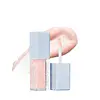What's inside
What's inside
 Key Ingredients
Key Ingredients

 Benefits
Benefits

 Concerns
Concerns

 Ingredients Side-by-side
Ingredients Side-by-side

Polybutene
Tridecyl Trimellitate
EmollientHydrogenated Polyisobutene
EmollientOctyldodecyl Stearoyl Stearate
EmollientSilica
AbrasivePentaerythrityl Tetraisostearate
EmollientPolyglyceryl-2 Diisostearate
EmulsifyingSilica Dimethyl Silylate
EmollientDisteardimonium Hectorite
StabilisingEthyl Vanillin
MaskingPropylene Carbonate
SolventAluminum Hydroxide
EmollientPentaerythrityl Tetra-Di-T-Butyl Hydroxyhydrocinnamate
AntioxidantDicalcium Phosphate
AbrasiveMica
Cosmetic ColorantCalcium Titanium Borosilicate
AbrasiveTocopherol
AntioxidantTin Oxide
AbrasiveCI 77891
Cosmetic ColorantCI 77492
Cosmetic ColorantCI 42090
Cosmetic ColorantCI 15850
Cosmetic ColorantCI 77742
Cosmetic ColorantPolybutene, Tridecyl Trimellitate, Hydrogenated Polyisobutene, Octyldodecyl Stearoyl Stearate, Silica, Pentaerythrityl Tetraisostearate, Polyglyceryl-2 Diisostearate, Silica Dimethyl Silylate, Disteardimonium Hectorite, Ethyl Vanillin, Propylene Carbonate, Aluminum Hydroxide, Pentaerythrityl Tetra-Di-T-Butyl Hydroxyhydrocinnamate, Dicalcium Phosphate, Mica, Calcium Titanium Borosilicate, Tocopherol, Tin Oxide, CI 77891, CI 77492, CI 42090, CI 15850, CI 77742
Oleic/Linoleic/Linolenic Polyglycerides
EmollientBis-Diglyceryl Polyacyladipate-2
EmollientRicinus Communis Seed Oil
MaskingPolyhydroxystearic Acid
EmulsifyingCaprylic/Capric Triglyceride
MaskingButyrospermum Parkii Butter
Skin ConditioningPersea Gratissima Oil
Skin ConditioningEthylhexyl Palmitate
EmollientMica
Cosmetic ColorantOryza Sativa Bran Extract
Skin ConditioningSilica Dimethyl Silylate
EmollientCalcium Sodium Borosilicate
Oenothera Biennis Oil
EmollientVanillin
MaskingHelianthus Annuus Extract
EmollientCaprylyl Glycol
EmollientCitrus Aurantium Dulcis Peel Oil
MaskingEthylhexylglycerin
Skin ConditioningSilica
AbrasiveTribehenin
EmollientRosmarinus Officinalis Leaf Extract
AntimicrobialTocopherol
AntioxidantSorbitan Isostearate
EmulsifyingTrihydroxystearin
Skin ConditioningSodium Hyaluronate
HumectantPalmitoyl Tripeptide-1
Skin ConditioningGlucomannan
Skin ConditioningCitral
PerfumingLimonene
PerfumingLinalool
PerfumingCI 77891
Cosmetic ColorantCI 77491
Cosmetic ColorantTin Oxide
AbrasiveCI 45410
Cosmetic ColorantOleic/Linoleic/Linolenic Polyglycerides, Bis-Diglyceryl Polyacyladipate-2, Ricinus Communis Seed Oil, Polyhydroxystearic Acid, Caprylic/Capric Triglyceride, Butyrospermum Parkii Butter, Persea Gratissima Oil, Ethylhexyl Palmitate, Mica, Oryza Sativa Bran Extract, Silica Dimethyl Silylate, Calcium Sodium Borosilicate, Oenothera Biennis Oil, Vanillin, Helianthus Annuus Extract, Caprylyl Glycol, Citrus Aurantium Dulcis Peel Oil, Ethylhexylglycerin, Silica, Tribehenin, Rosmarinus Officinalis Leaf Extract, Tocopherol, Sorbitan Isostearate, Trihydroxystearin, Sodium Hyaluronate, Palmitoyl Tripeptide-1, Glucomannan, Citral, Limonene, Linalool, CI 77891, CI 77491, Tin Oxide, CI 45410
Ingredients Explained
These ingredients are found in both products.
Ingredients higher up in an ingredient list are typically present in a larger amount.
Ci 77891 is a white pigment from Titanium dioxide. It is naturally found in minerals such as rutile and ilmenite.
It's main function is to add a white color to cosmetics. It can also be mixed with other colors to create different shades.
Ci 77891 is commonly found in sunscreens due to its ability to block UV rays.
Learn more about CI 77891Mica is a naturally occurring mineral used to add shimmer and color in cosmetics. It can also help improve the texture of a product or give it an opaque, white/silver color.
Serecite is the name for very fine but ragged grains of mica.
This ingredient is often coated with metal oxides like titanium dioxide. Trace amounts of heavy metals may be found in mica, but these metals are not harmful in our personal products.
Mica has been used since prehistoric times throughout the world. Ancient Egyptian, Indian, Greek, Roman, Aztec, and Chinese civilizations have used mica.
Learn more about MicaSilica, also known as silicon dioxide, is a naturally occurring mineral. It is used as a fine, spherical, and porous powder in cosmetics.
Though it has exfoliant properties, the function of silica varies depending on the product.
The unique structure of silica enhances the spreadability and adds smoothness, making it a great texture enhancer.
It is also used as an active carrier, emulsifier, and mattifier due to its ability to absorb excess oil.
In some products, tiny microneedles called spicules are made from silica or hydrolyzed sponge. When you rub them in, they lightly polish away dead skin layers and enhance the penetration of active ingredients.
Learn more about SilicaThis silica is mainly used to thicken oils and suspend particles in oils. It is not water soluble.
According to the manufacturer, it:
The manufacturer also claims this ingredient to be useful in makeup.
In lipstick formulations, this ingredient improves color payoff, reduces pigment settling, and reduces oil bleeding. This ingredient also improves the grip of powder products such as dry shampoos.
Learn more about Silica Dimethyl SilylateTin Oxide is an inorganic oxide used to add opacity and volume to a product. In nature, it is already found in mineral form. The main ore of tin is an opaque and shiny mineral called casseterite.
Tin Oxide helps remove translucency in a product, or make it more opaque. Besides adding opacity, tin oxide is used for bulking to add volume.
Tocopherol (also known as Vitamin E) is a common antioxidant used to help protect the skin from free-radicals and strengthen the skin barrier. It's also fat soluble - this means our skin is great at absorbing it.
Vitamin E also helps keep your natural skin lipids healthy. Your lipid skin barrier naturally consists of lipids, ceramides, and fatty acids. Vitamin E offers extra protection for your skin’s lipid barrier, keeping your skin healthy and nourished.
Another benefit is a bit of UV protection. Vitamin E helps reduce the damage caused by UVB rays. (It should not replace your sunscreen). Combining it with Vitamin C can decrease sunburned cells and hyperpigmentation after UV exposure.
You might have noticed Vitamin E + C often paired together. This is because it is great at stabilizing Vitamin C. Using the two together helps increase the effectiveness of both ingredients.
There are often claims that Vitamin E can reduce/prevent scarring, but these claims haven't been confirmed by scientific research.
Learn more about Tocopherol